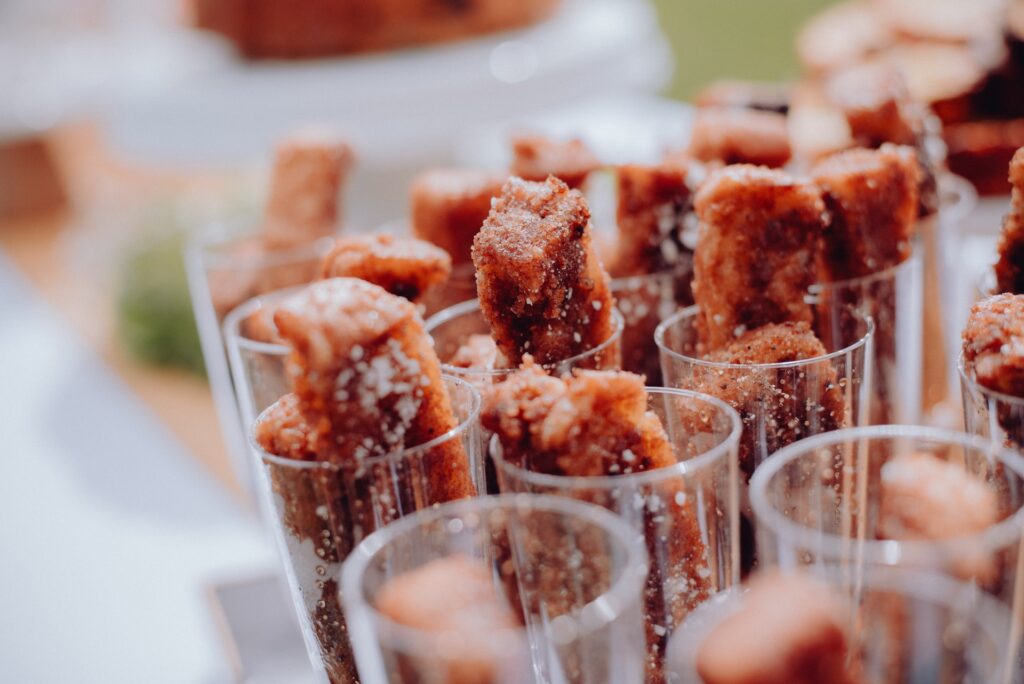
A lot has changed in the event industry because of COVID. Now, hybrid events are on the rise and many venues are giving virtual tours instead of in-person ones. Safety precautions have increased at events nationwide, too, like social distancing and even showing proof of vaccination. And while most of these precautions won’t stick around once the pandemic is over, there are a few trends that will have a place in the industry going forward. Single-serve food is one of those trends.
Single-serve food is exactly what it sounds like—food that is packaged for one individual person. This may be an entire meal in a box, or it could be a variety of snacks in cups. Ultimately, it doesn’t matter what food you’re serving. The goal is to remove the risk of guests touching each other’s food. This, in turn, reduces the amount of germs that are spread at an event, especially during a pandemic. Single-serve food can also help keep guests properly distanced, so they’re not crowding around a buffet table.
But, as with any safety precaution, there are ways to do it right and ways to do it less safely. In this post, we’re going to address some of the do’s and dont’s of single-serve food, so your guests and your team can remain as safe as possible.
Do serve food in containers

For single-serve food to be the safest, it should be served in individual containers. This could be parfait cups with fruit and yogurt, or veggie cups with dip on the bottom. But it could also mean sandwiches and chips in to-go containers. The main goal is to make sure that guests can grab their own food without touching anyone else’s. It’s important during COVID, and it’s important for sanitation during any event.
Don’t let guests crowd the food tables
If you serve your food in containers, but let guests crowd around the table to grab them, you’re still putting your guests at risk. While you may be keeping the food safe, you won’t be keeping your guests safe because they’ll be in close quarters when they pick out their food. Instead of letting everyone rush to the food table, dismiss each table one by one and ask them to form a single-file line, preferably with some distance between each person. (You can add tape along the floor to keep guests apart to be extra cautious.)
Do provide single-serve drinks

Yes, single-serve food is important. But don’t forget the drinks! Your guests will get thirsty, so you should hand out drinks, too. Thankfully, you don’t need to divide juice and water into cups ahead of time. Instead, you can simply offer bottled juices, water, and soda. You can serve them with the food or have them out at a beverage station. But just remember to not let guests crowd around the drinks, either!
Don’t forget napkins or utensils
For an event with table seating, you can set each place with napkins and utensils. But for a more casual, choose-your-own-seating event, pack the appropriate materials along with the food. That way, guests have what they need along with their meal.
Of course, guests may need extra napkins or drop their fork, so you should provide those, too. But, as you’ve probably guessed by now, you can pre-package them like everything else! That way, guests still won’t have to touch each other’s utensils.
Do serve guests while seated
If there isn’t room for food and drink tables, or if you’re concerned about crowding, you can simply serve the guests while they’re seated. This is an easy way to keep the guests safe from crowding, and you can make sure everyone gets their snacks or meal. If you decide to do this, you should take your guests’ orders before serving them. You can collect their meal preferences with their RSVPs or go around and ask each table before the meal.
Don’t make it complicated

Yes, single-serve food will keep your guests safe. But it’s also a lot of extra work for you to package all the food. And if you’re not the one packing the food, it can cost extra for the caterer to serve individual snacks and meals. So when you’re planning your menu, keep it simple. Don’t pick food that needs to stay super warm—or super cold. And don’t try any new or complicated recipes. There are plenty of easy, delicious recipes to choose from! You don’t need to give you and your team more work than necessary.
Conclusion
Providing single-serve food and drink at your next event is a great way to keep everyone safe—the guests and the hosts alike. It reduces the risk of guests touching each other’s food and spreading germs. Plus, it can even help reduce food waste because hosts tend to over-estimate how much guess will eat at a buffet. Just be sure to consider utensils, napkins, and other meal-time needs so your guests are still comfortable.
Share a single-serve food recipe with us below!

